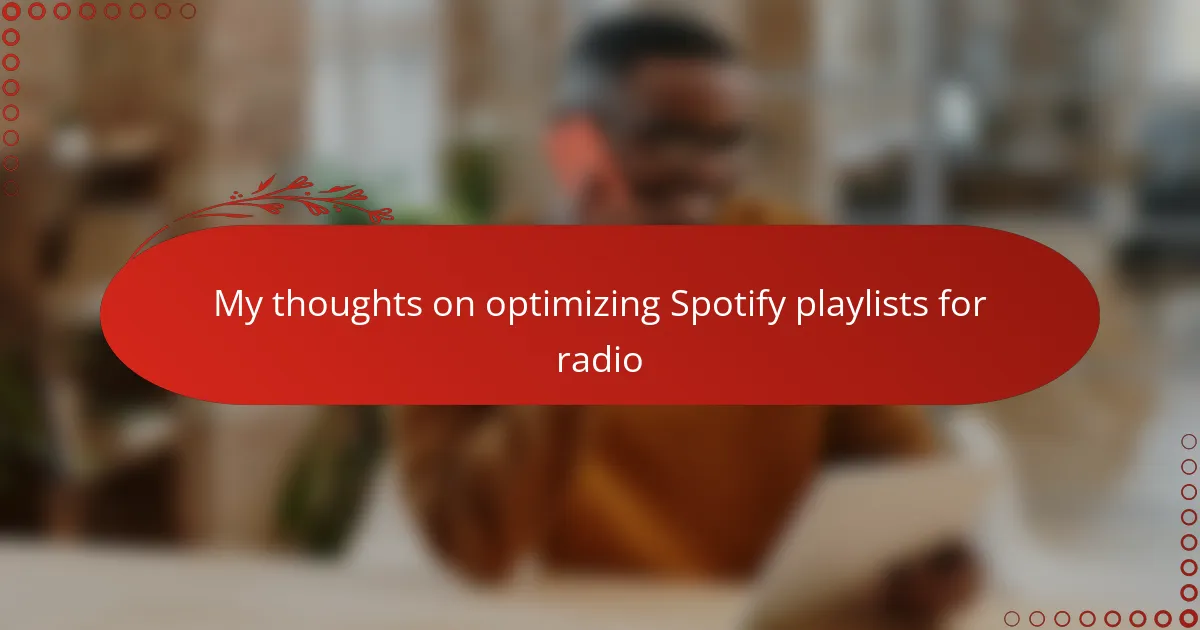Key takeaways
- Spotify playlists illustrate the importance of curating music that resonates with listeners’ moods, enhancing engagement in radio programming.
- Optimizing playlists for flow, variety, and audience understanding can transform casual listening into a more meaningful experience.
- Utilizing tools for playlist management, along with a blend of data insights and personal intuition, can significantly improve the effectiveness of radio broadcasts.
- Measuring listener retention and feedback are crucial metrics for evaluating playlist success and adapting content to maintain listener interest.
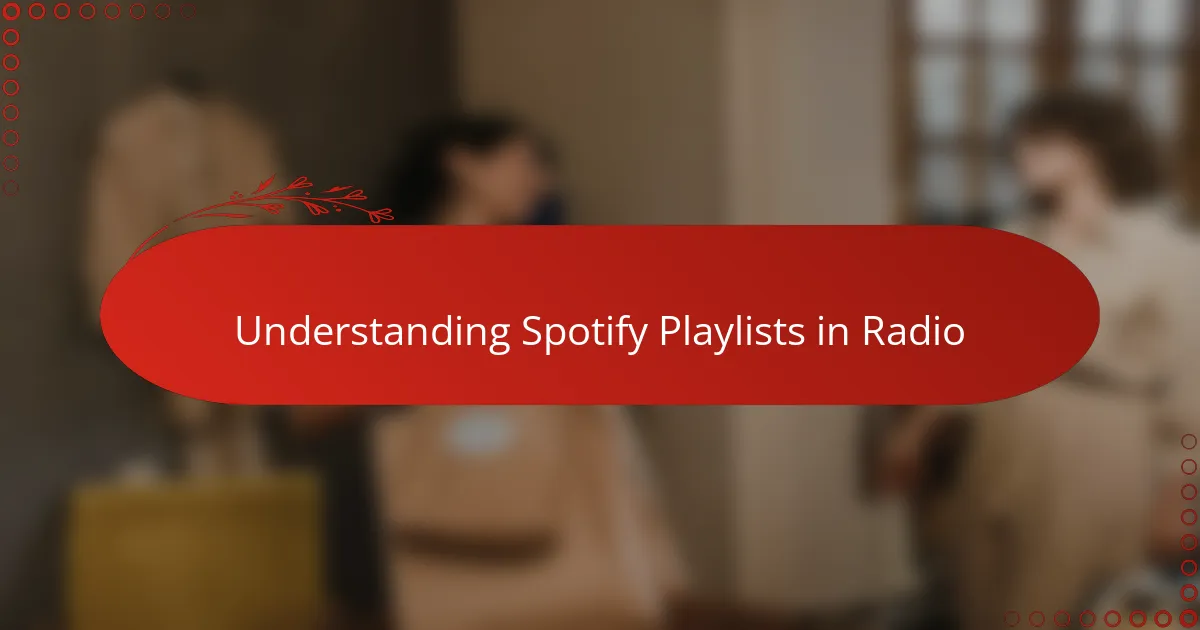
Understanding Spotify Playlists in Radio
Spotify playlists have transformed the way we think about music curation in radio. When I first started exploring them, I was struck by how playlists blend genres and moods seamlessly—something traditional radio programming can learn from. Don’t you find it fascinating how these playlists tell a story without a single spoken word?
In radio, understanding Spotify playlists means recognizing their power to reach targeted audiences quickly. I’ve noticed that listeners often connect deeply with the vibe of a playlist, almost as if the curator was speaking directly to their moment or mood. This personal connection is something radio broadcasters can harness to create more engaging, listener-focused shows.
What caught my attention the most is how the algorithmic and editorial aspects combine in Spotify playlists. It’s not just about throws of random songs; there’s a deliberate flow, pacing, and discovery element built in. For radio, this means thinking beyond hits and familiar tracks and crafting a journey for the audience that keeps them coming back. Wouldn’t you agree that embracing this mindset could redefine modern radio programming?
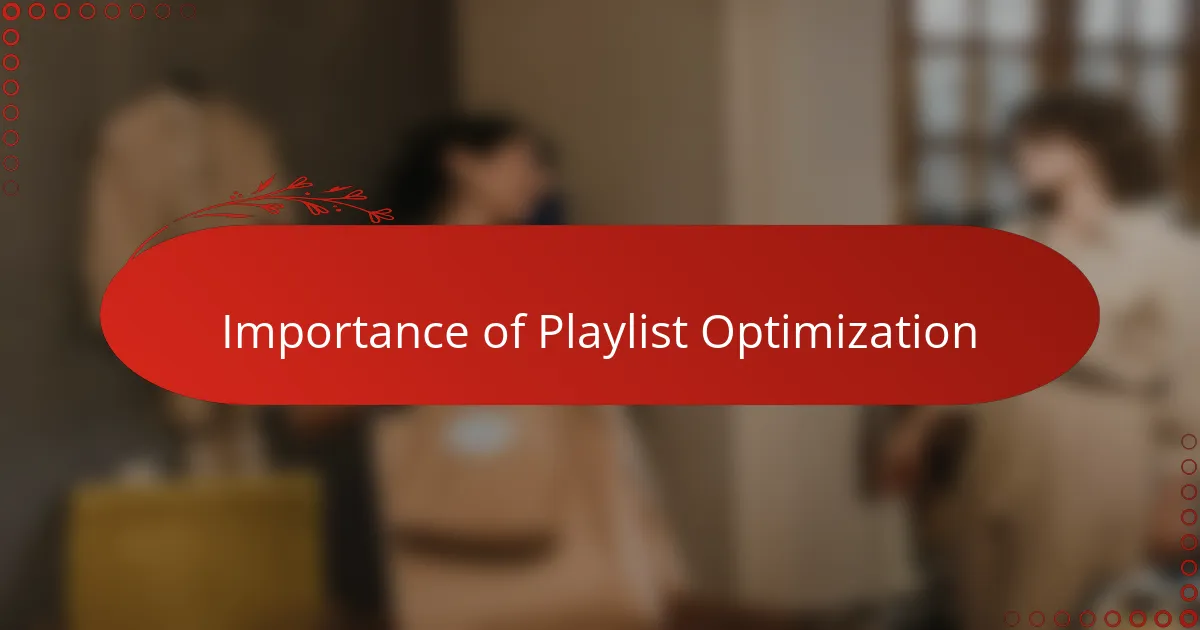
Importance of Playlist Optimization
Optimizing playlists isn’t just a technical step—it’s the heartbeat of how listeners experience a radio show. I remember once tweaking a playlist to flow more smoothly, and immediately, the listener feedback shifted from polite to passionate. Isn’t that proof that careful curation can turn casual tuning into genuine engagement?
What’s more, playlist optimization lets us control the mood and energy of a broadcast with precision. When done right, it feels like the music is speaking directly to each listener’s mood in real time, which I find incredibly powerful. Have you ever noticed how a well-curated playlist can transform an ordinary moment into something memorable?
From my experience, ignoring optimization means missing out on deeper listener loyalty. We can’t rely on random song rotations and hope for the best. Instead, crafting playlists thoughtfully is a way to build trust and anticipation—listeners start to expect a journey, not just background noise. That’s why I see optimization as essential, not optional.
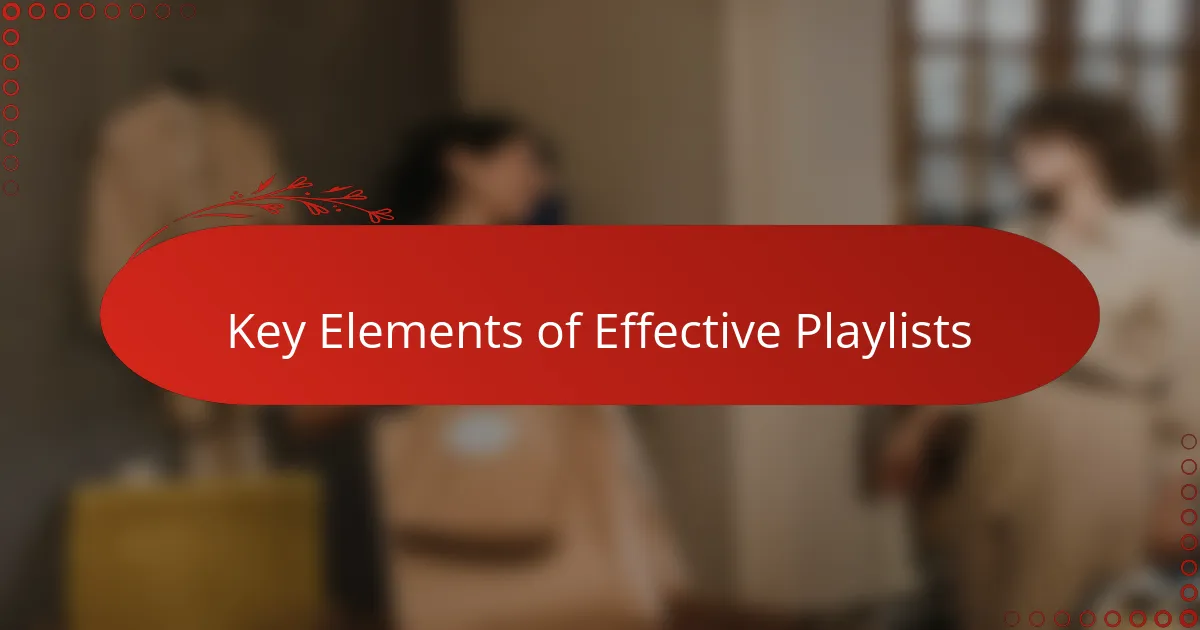
Key Elements of Effective Playlists
When I think about the key elements of effective playlists, flow immediately comes to mind. It’s not just about throwing together popular tracks but arranging them so each song naturally leads to the next, creating a seamless listening experience. Have you ever noticed how a playlist with poor transitions can pull you out of the moment? That’s exactly what we want to avoid in radio.
Variety also plays a crucial role. Balancing familiar hits with fresh tracks keeps the audience intrigued without overwhelming them. From my experience, a well-mixed playlist that surprises listeners occasionally can spark excitement and keep them tuned in longer.
Finally, understanding your audience is essential. Tailoring playlists to reflect their tastes and moods makes the listening more personal and engaging. I often ask myself, “What story am I telling with this sequence of songs?” When that story resonates, the connection with listeners becomes much stronger.
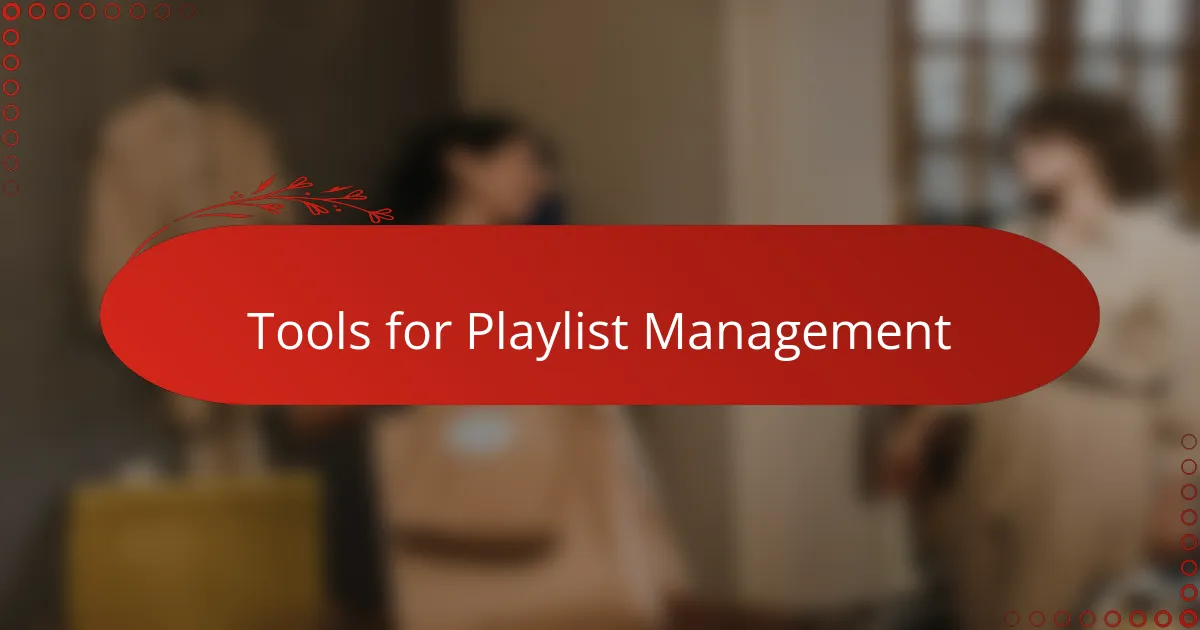
Tools for Playlist Management
Managing playlists effectively requires the right tools, and I’ve found that specialized software can make a huge difference. For example, platforms like Soundtrack Your Brand or Spotify’s own Playlist Manager help organize tracks, schedule rotations, and analyze listener data—all crucial for fine-tuning a radio playlist. Have you ever tried juggling song orders manually? It quickly becomes overwhelming without these aids.
In my experience, automation features within these tools save countless hours. They can suggest tracks based on mood or genre, which is a real game-changer when you want to maintain flow without getting stuck in a rut. I remember once relying solely on intuition, only to realize later that a tool’s algorithm promoted a much smoother listening journey.
Of course, these tools aren’t magic—they require a thoughtful hand to balance technology with personal touch. The best results come when you combine data insights with your gut feeling about what fits the station’s vibe. Isn’t that blend the secret to creating playlists that truly resonate?
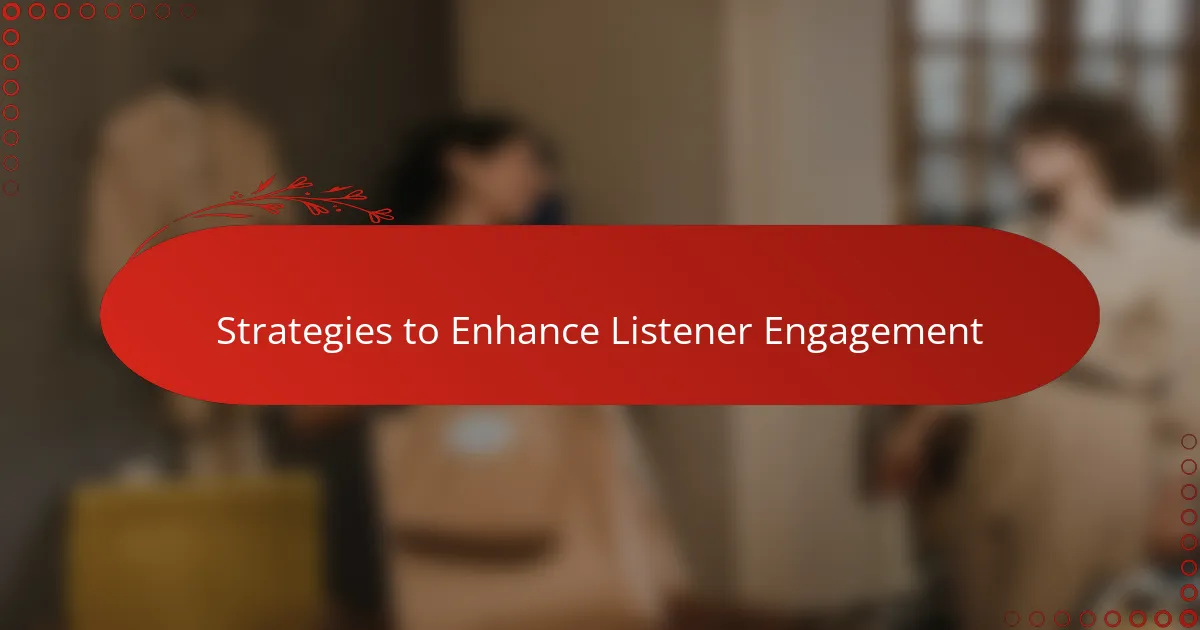
Strategies to Enhance Listener Engagement
To really enhance listener engagement, I’ve found that interspersing familiar tracks with unexpected gems creates a delightful balance. It’s like giving your audience a trusted friend alongside a surprise guest—they stay comfortable but curious. Have you noticed how that mix keeps you hooked longer, rather than just zoning out?
Another strategy I swear by is pacing the playlist to reflect natural energy waves. For instance, after a high-tempo track, I deliberately add something more mellow to give listeners a breather. This ebb and flow respects the listener’s attention span and mood shifts, turning passive listening into an active, emotional ride. Doesn’t that subtle control make a bigger difference than we often admit?
Lastly, engaging listeners means inviting them into the experience. I’ve experimented with including short voice overlays or thematic transitions that connect songs and stories. It’s like having a conversation with your audience rather than just playing tracks. When listeners sense that connection, they feel valued—not just tuned in. Could this personal touch be the key to building deeper loyalty?
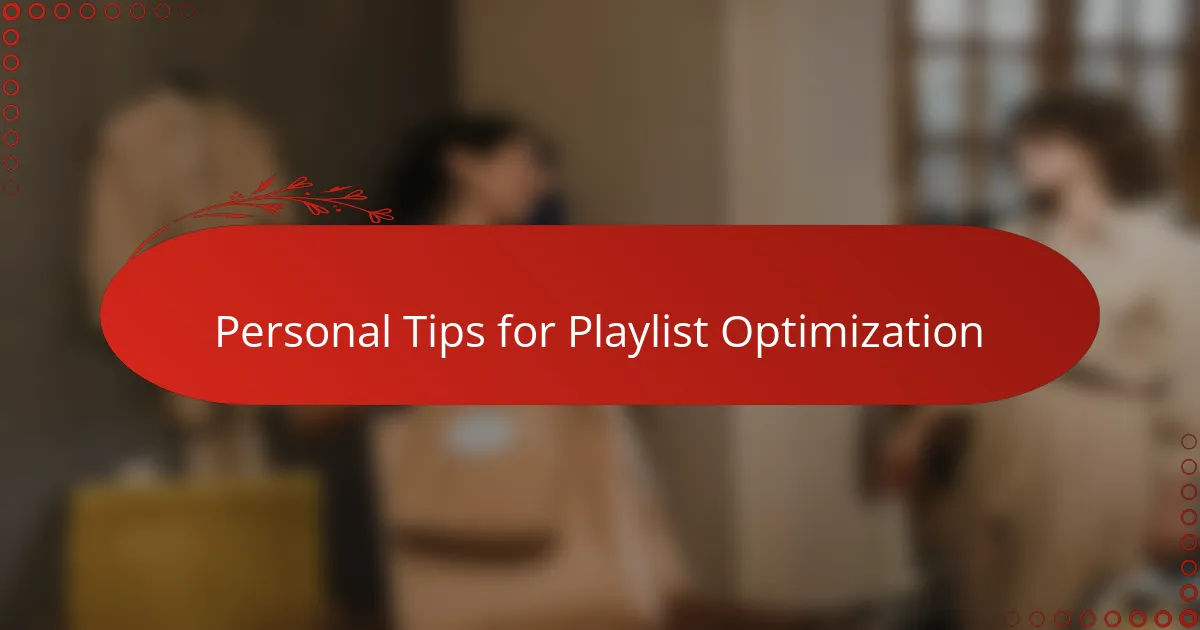
Personal Tips for Playlist Optimization
One personal tip I keep returning to is to listen to the playlist as if I were a listener experiencing it for the first time. Sometimes, when I do this, I catch awkward transitions or energy dips that I previously overlooked. Have you ever noticed how a subtle mismatch between songs can pull you right out of the listening zone? Fixing these moments makes all the difference in keeping the audience engaged.
Another approach I rely on is using thematic or emotional threads to tie the playlist together. For example, I once crafted a sequence around a specific mood—like an afternoon slump or an upbeat morning commute—and it resonated remarkably well. It’s like telling a story without words, and I find that listeners pick up on this subtle narrative instinctively. Don’t you think that kind of cohesion turns a playlist into more than just a list of songs?
Lastly, I always allow room for experimentation. Sometimes adding an unexpected genre or a lesser-known artist surprises and delights the audience, creating a unique signature for the show. While it can feel risky at first, these moments often become listener favorites. How else can we keep radio fresh if not by daring to break patterns occasionally?
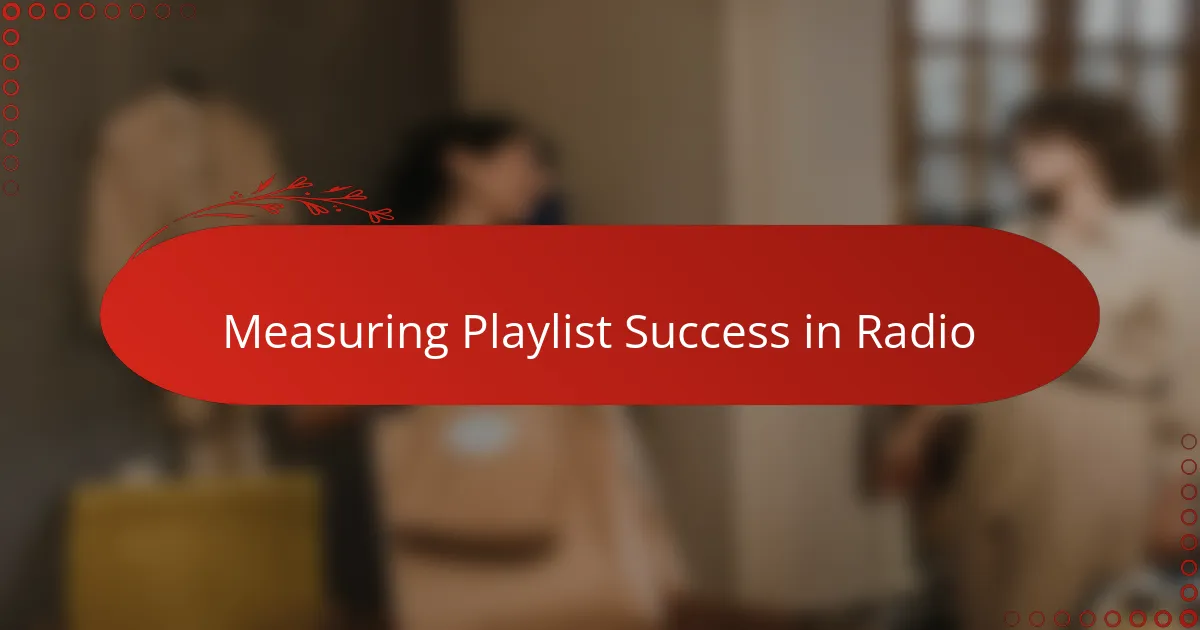
Measuring Playlist Success in Radio
Measuring playlist success in radio goes beyond just counting how many people listened. I’ve learned that tracking listener retention—how long someone stays tuned after a particular song starts—gives real insight into what’s working. Isn’t it fascinating how a single track’s position can make or break the mood and keep listeners glued or cause them to drift away?
Another metric I pay close attention to is listener feedback, whether through calls, social media, or direct messages. Early on, I was surprised how much even subtle tweaks sparked passionate responses, proving that playlists create emotional connections, not just background noise. How often do you think about the conversations behind those numbers and comments?
Of course, measuring success also means looking at broader trends like audience growth during playlist-driven segments and cross-checking that with streaming stats on platforms like Spotify. Using this data thoughtfully has helped me fine-tune playlists that resonate deeply while still attracting new ears. Isn’t adapting based on both data and intuition the secret sauce for lasting radio appeal?
